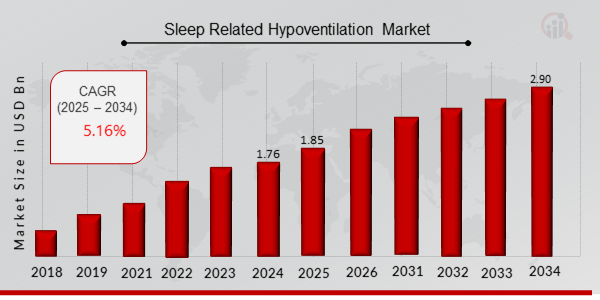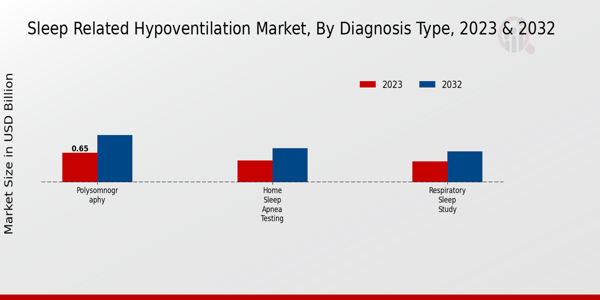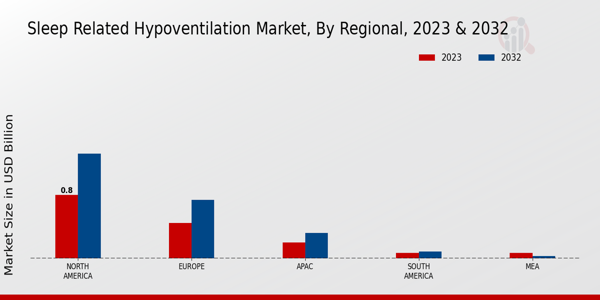Global Sleep Related Hypoventilation Market Overview
As per MRFR analysis, the Sleep Related Hypoventilation Market Size was estimated at 1.76 (USD Billion) in 2024. The Sleep Related Hypoventilation Market Industry is expected to grow from 1.85 (USD Billion) in 2025 to 2.90 (USD Billion) till 2034, at a CAGR (growth rate) is expected to be around 5.16% during the forecast period (2025 - 2034).
Key Sleep Related Hypoventilation Market Trends Highlighted
The Global Hypoventilation Related to Sleep market is projected to grow owing to the growing incidence of sleep-related disorders, rising awareness regarding sleep hygiene, and technological developments in diagnosis as well as the treatment of consumers with respiratory illnesses. The prevalence of the elderly population, which is more vulnerable to respiratory ailments, remains a major force. In furtherance, market growth is boosted due to the increasing trend of home healthcare solutions and the availability of portable devices for the monitoring and treatment of hypoventilation.
There is an increasing level of unmet need for effective therapeutic solutions for hypoventilation as a result of proliferation of companies seeking to introduce more efficient treatment options and better patient outcomes.
Providers of healthcare are now experiencing opportunities as the need for certain therapies and devices which would address people with sleep-related hypoventilation is evident. New technologies in telemedicine and remote monitoring are providing better ways to cope with these conditions. The potential of artificial intelligence and machine learning in enhancing the efficacy of sleep management devices and systems is useful. It may result in the improvement of diagnosis and development of specific treatments for individual patients. The emphasis on education relating to dietary and fitness-related changes places a promising platform for market players.
Manufacturers and representatives of the healthcare system, it’s been noticed for a while now, have been working together more and more. These collaborations want to make the products better, as well as get the patients more active in taking care of their conditions. The ever-increasing dominance of digital health technologies is changing the ways in which patients receive services from their healthcare providers. There is a shift towards the importance of patient-centered care and there is a regulatory push towards the development of novel therapies making it easier to capture the market of sleep-related hypoventilation in clinical and home settings.

Source: Primary Research, Secondary Research, Market Research Future Database and Analyst Review
Sleep Related Hypoventilation Market Drivers
Increasing Prevalence of Sleep Disorders
The Sleep Related Hypoventilation Market Industry is significantly driven by the growing awareness and diagnosis of sleep disorders. As more individuals experience symptoms related to sleep apnea, hypoventilation, and other respiratory issues during sleep, the demand for effective management solutions has surged. This increase in awareness, coupled with advancements in diagnostic tools and technologies, has led to a rise in the number of diagnosed cases.Population demographics, including an aging population and rising obesity rates, play a crucial role in exacerbating the prevalence of these disorders.
Consequently, healthcare systems are focusing on improving access to treatment and management options, fostering a healthier sleep environment for individuals. Furthermore, educational initiatives aimed at promoting better sleep hygiene have gained traction, highlighting the importance of sleep quality and the associated health implications.As more people seek help for sleep-related issues, the Sleep Related Hypoventilation Market is poised to benefit immensely from this trend, propelling market growth in the coming years. Innovations in therapeutic devices and methods will likely align with the increasing patient base, driving further investment and development within the sector.
Another contributing factor is the evolving understanding of comorbidities associated with sleep disorders, leading to holistic treatment approaches and integrating sleep medicine with other healthcare domains, thus widening the potential customer base in the Sleep Related Hypoventilation Market Industry.
Technological Advancements in Treatment Devices
Technological innovations and improvements in treatment devices are key drivers for the Sleep Related Hypoventilation Market Industry. The introduction of advanced continuous positive airway pressure (CPAP) machines, auto-adjusting devices, and wearable technologies has significantly improved the management of sleep-related hypoventilation. These devices offer enhanced comfort, better patient compliance, and increased treatment efficiency.
The integration of artificial intelligence and data analytics in sleep therapy devices is enabling more personalized treatment plans, adapting to individual patient needs, and enhancing overall outcomes.This continuous evolution in technology is creating a competitive advantage for manufacturers and fostering market growth as more healthcare providers and patients seek cutting-edge solutions for effective sleep management.
Growing Demand for Home Healthcare Solutions
The shift towards home healthcare solutions is becoming an influential driver for the Sleep Related Hypoventilation Market Industry. With the rising emphasis on convenience and cost-effectiveness, more patients prefer to manage their sleep-related conditions within the comfort of their homes. Home care devices, including portable monitoring systems and therapy devices, are gaining popularity as they allow for the easy management of hypoventilation without the need for frequent hospital visits.This growing preference for at-home treatment options is fueled by advancements in technology that enable patients to conduct self-assessments and receive remote monitoring support from healthcare professionals.
As the demand for home healthcare solutions continues to rise, so does the opportunity for growth in the sleep-related hypoventilation segment as more individuals seek accessible and user-friendly treatment alternatives.
Sleep Related Hypoventilation Market Segment Insights
Sleep Related Hypoventilation Market Diagnosis Type Insights
The Sleep Related Hypoventilation Market, particularly in the Diagnosis Type segment, showcases a diverse array of diagnostic approaches that cater to the rising prevalence of sleep disorders. In 2023, the market particularly emphasized various diagnostic techniques, with Polysomnography being a dominant player, valued at 0.65 USD Billion. Polysomnography, due to its comprehensive nature in recording various physiological parameters, significantly retains its importance and appeals to both clinicians and patients. Home Sleep Apnea Testing, valued at 0.48 USD Billion, has gained traction as a convenient alternative to traditional methods, emphasizing the growing trend of at-home healthcare solutions.
This method reflects a shift in patient preferences towards more accessible diagnostic options without compromising on accuracy. In comparison, the Respiratory Sleep Study holds a valuation of 0.46 USD Billion as of 2023, recognizing its role in understanding complex sleep-related breathing disorders. The significance of these diagnostic strategies lies not only in their individual market valuations but also in how they collectively enhance the understanding and management of sleep hypoventilation.
The Sleep Related Hypoventilation Market data indicates a strong inclination toward advanced and patient-friendly diagnostic methods that will likely fuel market growth in the coming years.With market segments projected to expand, there are substantial opportunities for innovation and technological advancements that can lead to enhanced patient outcomes. However, one of the challenges faced is ensuring the accuracy and reliability of these home-based testing procedures equate to traditional monitoring methods. Overall, the market statistics provide a clear picture of how the Diagnosis Type segment is evolving, driven by patient demand for comfort, accessibility, and effective detection methods in managing sleep disorders.

Source: Primary Research, Secondary Research, Market Research Future Database and Analyst Review
Sleep Related Hypoventilation Market Product Type Insights
The Sleep Related Hypoventilation Market, valued at 1.59 billion USD in 2023, showcases a diverse range of Product Types essential for addressing hypoventilation issues. Among these, Continuous Positive Airway Pressure (CPAP) Devices have emerged as a foundational technology, effectively providing constant airflow to keep airways open during sleep. Bilevel Positive Airway Pressure (BiPAP) Devices offer a dual-pressure system, allowing for different inhalation and exhalation pressures, thus enhancing comfort and therapeutic effectiveness.
Adaptive Servo-Ventilation (ASV) Devices further represent an innovative approach, adjusting pressure automatically based on real-time analysis of breathing patterns, thus catering to a variety of patient needs.This innovative market segment continues to thrive, driven by an increasing prevalence of sleep disorders, a growing geriatric population, and advancements in device technology. With a majority of the market attributed to CPAP Devices, they play a significant role in reducing the impact of sleep-related hypoventilation on overall health.
Furthermore, the steady demand for improved patient experience and comfort fuels growth in BiPAP and ASV Devices as well, making them vital components of the Sleep Related Hypoventilation Market landscape.
Sleep Related Hypoventilation Market End Use Insights
The Sleep Related Hypoventilation Market is evolving, with a valuation of 1.59 billion USD in 2023, projected to reach 2.5 billion USD by 2032. The market segmentation highlights the importance of diverse End Use categories, particularly Hospitals, Homecare Settings, and Sleep Clinics. Hospitals play a crucial role in the management of sleep-related issues, and they are equipped with advanced technology and skilled professionals to provide comprehensive care. Meanwhile, home care settings offer increasing convenience for patients, allowing for effective management of hypoventilation in a comfortable environment and contributing significantly to market growth.
Sleep Clinics also remain significant as specialized facilities that cater specifically to diagnosing and treating sleep disorders, thus driving demand for tests and treatments related to sleep hypoventilation. The interplay of these segments is vital in shaping the Sleep Related Hypoventilation Market data, with trends such as technological advancements and growing awareness of sleep disorders acting as growth drivers, while challenges like the high cost of treatments may hinder widespread access. Overall, the Sleep Related Hypoventilation Market industry is poised for steady expansion, driven by an increasing understanding of sleep health.
Sleep Related Hypoventilation Market Age Group Insights
The Sleep Related Hypoventilation Market segment focused on Age Group reveals a diverse landscape with distinct needs and trends across different demographics. In 2023, the market reached a valuation of 1.59 billion USD, reflecting a growing awareness of sleep-related issues. The segment encompasses Children, Adults, and the Elderly, each contributing uniquely to the overall market dynamics. Children represent a significant focus due to the increasing recognition of pediatric sleep disorders, driving demand for innovative solutions tailored to younger populations.Adults constitute a major portion of the market, accounting for lifestyle-related sleep challenges that underscore the necessity for effective interventions.
Meanwhile, the Elderly demographic is experiencing heightened attention due to the aging population and associated health concerns such as obesity and chronic conditions, creating a substantial opportunity for market growth. These dynamics in the Sleep Related Hypoventilation Market segmentation highlight the importance of specialized products and services aimed at varied age groups, steering industry developments and addressing diverse consumer needs.The trends in the market reflect the escalating focus on enhancing sleep quality across all age categories, driven by factors like rising healthcare expenditures and increasing sleep disorder awareness.
Sleep Related Hypoventilation Market Regional Insights
The Sleep Related Hypoventilation Market revenue is expected to reach 1.59 USD Billion in 2023, reflecting various regional dynamics driving the market growth. North America dominates with a valuation of 0.8 USD Billion, projected to expand to 1.32 USD Billion by 2032, highlighting its majority holding due to high prevalence and advanced healthcare infrastructure.
Europe follows with a valuation of 0.45 USD Billion in 2023 and is anticipated to reach 0.74 USD Billion in 2032, showcasing significant market potential fueled by increasing awareness.The APAC region, valued at 0.2 USD Billion in 2023 and expected to grow to 0.32 USD Billion, indicates a growing interest in sleep health solutions. South America and MEA hold values of 0.07 USD Billion and 0.07 USD Billion, respectively, for 2023, with South America projected to slightly increase to 0.09 USD Billion while MEA is anticipated to reach 0.03 USD Billion.
While North America remains the leading region due to healthcare advancements and consumer awareness, APAC presents burgeoning opportunities due to its increasing population and healthcare investments, with other regions catching up as sleep-related issues gain recognition globally.The Sleep Related Hypoventilation Market segmentation reflects these dynamics, showcasing the potential for growth across all regions.

Source: Primary Research, Secondary Research, Market Research Future Database and Analyst Review
Sleep Related Hypoventilation Market Key Players and Competitive Insights
The Sleep Related Hypoventilation Market is witnessing a significant evolution driven by increasing awareness regarding sleep disorders and the growing prevalence of conditions such as obesity and chronic respiratory diseases. The competitive landscape is defined by the presence of various stakeholders ranging from established companies to emerging players, each striving to innovate and capture market share. Innovations in treatment methods, devices, and technologies are fueling competition, with companies focused on developing advanced solutions like oral appliances and non-invasive ventilation devices. The landscape is further shaped by strategic partnerships, mergers and acquisitions, and a constant push toward enhancing patient outcomes.
These dynamics lead to a diverse product offering tailored to meet the varied needs of patients suffering from sleep-related hypoventilation, creating a competitive environment that encourages continuous improvement and investment in research and development.
SomnoMed has positioned itself as a key player in the Sleep Related Hypoventilation Market, with a distinct focus on providing innovative oral appliance therapy solutions. The company stands out through its proprietary SomnoDent product line, which is designed for the comfortable and effective management of obstructive sleep apnea and related hypoventilation conditions. SomnoMed's strength lies in its commitment to research and development, leading to the creation of personalized treatment options that enhance patient compliance and satisfaction.
The company has established a strong presence in various markets worldwide, utilizing effective distribution channels and collaborations with healthcare professionals to promote better awareness of sleep apnea treatment. Its focus on education and awareness-raising initiatives has allowed SomnoMed to build a trustworthy brand recognized for quality and patient-oriented solutions in the field of sleep medicine.Drive DeVilbiss Healthcare has carved a notable niche within the Sleep Related Hypoventilation Market by offering an expansive range of respiratory and sleep therapy products.
The company's strengths are deeply embedded in its commitment to innovation, quality, and comprehensive patient care solutions. Drive DeVilbiss Healthcare provides advanced technologies and devices designed to enhance the management of sleep-related hypoventilation, focusing on delivering high-quality continuous positive airway pressure devices known for their performance and reliability. Their extensive experience in respiratory care positions them effectively in this market, allowing them to cater to a broad spectrum of patient needs. Moreover, Drive DeVilbiss's global presence and well-established supply chain enhance accessibility to their products, making essential therapies more widely available to patients.
Their educational initiatives geared towards healthcare providers serve to reinforce the importance of effective treatment options and contribute to better health outcomes for individuals suffering from sleep-related hypoventilation.
Key Companies in the Sleep Related Hypoventilation Market Include
- Drive DeVilbiss Healthcare
- Fisher and Paykel Healthcare
Sleep Related Hypoventilation Market Industry Developments
Recent developments in the Sleep Related Hypoventilation Market have shown significant actions by leading companies in the sector. SomnoMed has been focusing on expanding its product offerings to address evolving consumer needs, while ResMed is enhancing its portfolio with advanced sleep apnea solutions. Drive DeVilbiss Healthcare and OxyHeal Health Group are also pushing forward with innovative therapeutic devices that aid patients with respiratory challenges. This competitive landscape has spurred an increase in market valuation, indicating a robust demand for effective treatment options.
Companies like Medtronic and Philips are actively investing in research and development to explore novel technologies that could reshape patient care in this field. In terms of mergers and acquisitions, there has been notable activity with companies looking to consolidate their market positions through strategic partnerships. For instance, Inspire Medical Systems and Breas Medical are rumored to be exploring potential collaborations that could leverage their respective strengths in critical care solutions. As the market continues to evolve, the emphasis on integrated healthcare services and technological advancements remains paramount, influencing consumer expectations and driving overall industry growth.
Sleep Related Hypoventilation Market Segmentation Insights
Sleep Related Hypoventilation Market Diagnosis Type Outlook
Sleep Related Hypoventilation Market Product Type Outlook
-
- Continuous Positive Airway Pressure Devices
- Bilevel Positive Airway Pressure Devices
- Adaptive Servo-Ventilation Devices
Sleep Related Hypoventilation Market End Use Outlook
Sleep Related Hypoventilation Market Age Group Outlook
Sleep Related Hypoventilation Market Regional Outlook
Beta feature
| Report Attribute/Metric |
Details |
|
Market Size 2024
|
1.76 (USD Billion)
|
|
Market Size 2025
|
1.85 (USD Billion)
|
|
Market Size 2034
|
2.90 (USD Billion)
|
|
Compound Annual Growth Rate (CAGR)
|
5.16 % (2025 - 2034)
|
|
Report Coverage
|
Revenue Forecast, Competitive Landscape, Growth Factors, and Trends
|
|
Base Year
|
2024
|
|
Market Forecast Period
|
2025 - 2034
|
|
Historical Data
|
2020 - 2024
|
| Market Forecast Units |
USD Billion |
| Key Companies Profiled |
SomnoMed, Drive DeVilbiss Healthcare, OxyHeal Health Group, Linde, Ventura Medical, Inspire Medical Systems, ResMed, AeroCare, Honeywell, Apria Healthcare, Curative Medical, Philips, Breas Medical, Medtronic, Fisher and Paykel Healthcare |
| Segments Covered |
Diagnosis Type, Product Type, End Use, Age Group, Regional |
| Key Market Opportunities |
Growing prevalence of sleep disorders, Advancements in wearable sleep technology, Increased awareness of sleep health, Expanding telemedicine solutions for diagnostics, Rising demand for home sleep studies |
| Key Market Dynamics |
increasing prevalence of sleep disorders, rising awareness of sleep health, advancements in diagnostic technology, growing demand for homecare solutions, increasing geriatric population |
| Countries Covered |
North America, Europe, APAC, South America, MEA |
Frequently Asked Questions (FAQ):
The Sleep Related Hypoventilation Market is expected to be valued at 2.5 billion USD in 2034.
The market is projected to grow at a CAGR of 5.16% from 2025 to 2034.
North America is expected to hold the largest market share, valued at 1.32 billion USD in 2034.
Polysomnography is projected to be valued at 1.05 billion USD in 2034.
The Home Sleep Apnea Testing segment is expected to reach a value of 0.76 billion USD in 2034.
Key players include SomnoMed, ResMed, and Medtronic, among others.
The Respiratory Sleep Study segment is estimated to be valued at 0.69 billion USD in 2034.
Asia-Pacific is projected to grow to 0.32 billion USD by 2034, with significant growth prospects.
Europe is expected to have a market value of 0.74 billion USD in 2034.
The growth drivers include increasing awareness of sleep disorders and technological advancements in diagnosis and treatment.

















